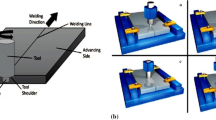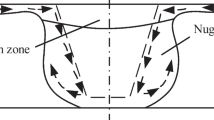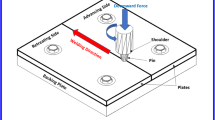Abstract
Effects of clamping area and welding speed on the development of residual stress fields in aluminum plates joined by the friction stir welding process were investigated in this paper. Friction stir welding on two aluminum alloy 6061-T6 plates was simulated in a three-dimensional, two-step thermo-mechanical analysis using the finite element program ANSYS. In the simulation, effects of welding tool plunging force, formation of heat-affected zone, and clamping fixture release were considered. The finite element results revealed that the clamping area plays a significant role on the formation and magnitude of friction welding-induced residual stresses. The models with greater clamping areas showed a 40 % lower maximum tensile residual stress in comparison with models with small clamping areas. Furthermore, for models with small clamping area, the effect of speed on the magnitude of residual stress was negligible. For models with large clamping area, the magnitude of maximum tensile residual stress was increased up to about 50 % with an increase of welding speed.
Similar content being viewed by others
References
Thomas WM, Nicholas ED, Needham JC, Murch MG, Temple-Smith P, Dawes CJ (1991) Friction stir butt welding. International patent application no. PCT/GB92102203 and Great Britain patent application no. 9125978.8
Zhu XK, Chao YJ (2004) Numerical simulation of transient temperature and residual stresses in friction stir welding of 304L stainless steel. J Mater Process Technol 146:263–272
Farajkhah V, Liu Y, Gannon LG (2016) Finite element study of 3D simulated welding effect in aluminium plates. Ships Offshore Struct. doi:10.1080/17445302.2015.1123865
Farajkhah V, Liu Y (2016) Effect of fabrication methods on the ultimate strength of aluminum hull girders. Ocean Eng 114:269–279
Beaulieu D (2006) Design of aluminum structures, 1st edn. Pral, Saguenay
Davis JR (1993) Aluminum and aluminum alloys, ASM speciality handbook. ASM Int
Sato Y, Kokawa H, Enomoto M, Jogan S (1999) Microstructural evolution of 6063 aluminum during friction stir welding. Metal Mater Trans A 30:2429–2437
Terasaki T, Akiyama T (2003) Mechanical behaviour of joints in FSW: residual stress, inherent strain and heat input generated by friction stir welding. Weld World 47:24–31
Chao YJ, Qi X (1998) Thermal and thermo-mechanical modeling of friction stir welding of aluminum alloy 6061-T6. J Mater Process Manuf Sci 7:215–233
Farajkhah V, Liu Y (2016) Effect of metal inert gas welding on the behaviour and strength of aluminum stiffened plates. Mar Struct 50:95–110
Steuwer A, Peel M, Withers M (2006) Dissimilar friction stir welds in AA5083–AA6082: the effect of process parameters on residual stress. Mater Sci Eng A 441:187–196
Wang XL, Feng XL, David SA, Spooner S, Hubbard CR (2000) Neutron diffraction study of residual stresses in friction stir welds, Proceeding of the 6th international conference on residual stresses [ICRS-6], vol 2. IOM Communications, Oxford, pp 1408–1414
Dalle Donne C, Lima E, Wegener J, Pyzalla A, Buslaps T (2001) Investigations on residual stresses in friction stir welds. Proceeding of the 3rd International Symposium on FSW, TWI, Cambridge, Kobe, Japan
Webster PJ, Oosterkamp LD, Browne PA, Hughes DJ, Kang WP, Withers PJ, Vaughan GBM (2001) Synchrotron X-ray residual strain scanning of a friction stir weld. J Strain Anal Eng Des 36(1):61–70
Sutton MA, Reynolds AP, Wang DQ, Hubbard CR (2002) A study of residual stresses and microstructure in 2024-T3 aluminum friction stir butt welds. Eng Mater Technol 124:215–221
Chao YJ, Qi X (1999) Heat transfer and thermo-mechanical modeling of friction stir joining of AA6061-T6 plates. Proceedings of the First International Symposium on Friction Stir Welding Thousand Oaks, CA, USA
Khandkar MZJ, Khan JA, Reynolds AP, Sutton MA (2006) Predicting residual thermal stresses in friction stir welded metals. J Mater Process Technol 174:195–203
Riahi M, Nazari H (2011) Analysis of transient temperature and residual thermal stresses in friction stir welding of aluminum alloy 6061-T6 via numerical simulation. Int J Adv Manuf Tech 55:143–152
Feng Z, Wang XL, David SA, Sklad P (2004) Modeling of residual stresses and property distributions in friction stir welding of aluminum alloy 6061-T6, 5th International Friction Stir Welding Symposium, Metz, France
Lombard H, Hattingh DG, Steuwer A, James MN (2009) Effect of process parameters on the residual stresses in AA5083-H321 friction stir welds. Mater Sci Eng A Struct 501:119–124
Bastier A, Maitournam MH, Roger F, Van KD (2008) Modelling of the residual state of friction stir welded plates. J Mater Process Technol 200:25–37
Moraitis GA, Labeas GN (2008) Residual stress and distortion calculation of laser beam welding for aluminum lap joints. J Mater Process Technol 198:260–269
Schmidt H, Hattel J, Wert J (2004) An analytical model for the heat generation in friction stir welding. Model Simul Mater Sci Eng 12(1):143–157
Chao YJ, Qi X, Tang W (2003) Heat transfer in friction stir welding—experimental and numerical studies. J Manuf Sci Eng Trans ASME 125:138–145
Guo JF, Chen HC, Sun CN, Bi G, Sun Z, Wei J (2014) Friction stir welding of dissimilar materials between AA6061 and AA7075 Al alloys effects of process parameters. Mater Des 56:185–192
Dalle Donne C, Lima E, Wegener J, Pyzalla A, Buslaps T (2001) Investigations on residual stresses in friction stir welds. In: TWI (ed) Proc 3rd int symp FSW, Kobe, Japan
Peel M, Steuwer A, Preuss M, Withers PJ (2003) Microstructure, mechanical properties and residual stresses as a function of welding speed in aluminium AA5083 friction stir welds. Acta Mater 51(16):4791–4801
John R, Jata KV, Sadananda K (2003) Residual stress effects on near-threshold fatigue crack growth in friction stir welds in aerospace alloys. Int J Fatigue 25:939–948
Staron P, Koak M, Williams S, Wescott A (2004) Residual stress in friction stir-welded Al sheets. Physica B 350(1–3,1):e491–e493
Woo W, Feng Z, Wang X-L, Brown DW, Clausen B, An K, Choo H, Hubbard CR, David SA (2007) In situ neutron diffraction measurements of temperature and stresses during friction stir welding of 6061-T6 aluminium alloy. Sci Technol Weld Join 12(4):298–302
Altenkirch J, Steuwer A, Peel MJ, Withers PJ, Williams SW, Poad M (2008) Mechanical tensioning of high-strength aluminium alloy friction stir welds. Metall Mater Trans A 39:3246–3259
Pouget G, Reynolds AP (2008) Residual stress and microstructure effects on fatigue crack growth in AA2050 friction stir welds. Int J Fatigue 30:463–472
Deplus K, Simar A, Van Haver W, De Meester B (2011) Residual stresses in aluminium alloy friction stir welds. Int J Adv Manuf Technol 56:493–504
Buffa G, Fratini L, Pasta S, Shivpuri R (2008) On the thermo-mechanical loads and the resultant residual stresses in friction stir processing operations. Manuf Technol 57:287–290
Author information
Authors and Affiliations
Corresponding author
Rights and permissions
About this article
Cite this article
Farajkhah, V., Liu, Y. Effect of clamping area and welding speed on the friction stir welding-induced residual stresses. Int J Adv Manuf Technol 90, 339–348 (2017). https://doi.org/10.1007/s00170-016-9393-7
Received:
Accepted:
Published:
Issue Date:
DOI: https://doi.org/10.1007/s00170-016-9393-7




